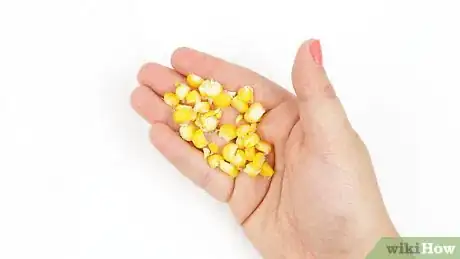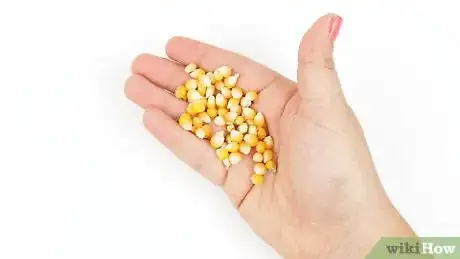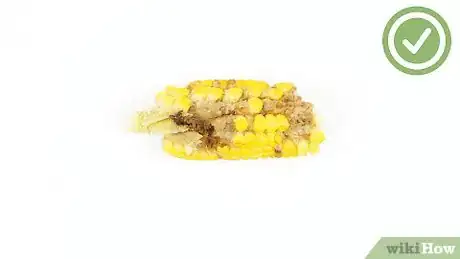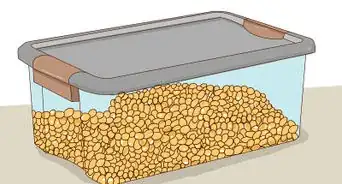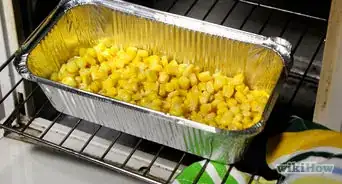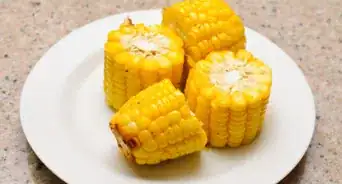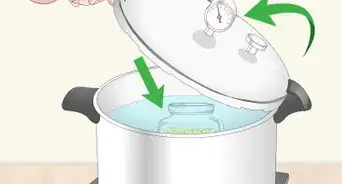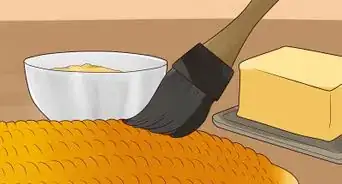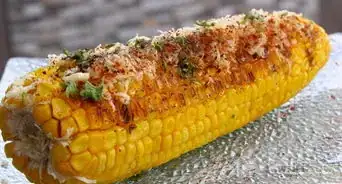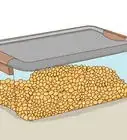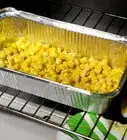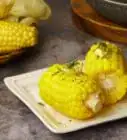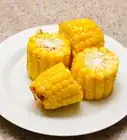This article was co-authored by wikiHow Staff. Our trained team of editors and researchers validate articles for accuracy and comprehensiveness. wikiHow's Content Management Team carefully monitors the work from our editorial staff to ensure that each article is backed by trusted research and meets our high quality standards.
There are 11 references cited in this article, which can be found at the bottom of the page.
The wikiHow Video Team also followed the article's instructions and verified that they work.
This article has been viewed 37,071 times.
Learn more...
Cracking corn breaks kernels down into smaller pieces that are easier for birds and other animals to digest. The corn needs to be shucked and dried to prepare it for grinding. Then, run it through a grain mill or meat grinder at a low grind setting. The best corn to use is dent corn, although clean popcorn kernels also crack well and make for quality feed.
Steps
Cleaning and Drying Fresh Corn
-
1Peel the husks and silk off of the corn. Hold onto the ear of corn and peel away the outer leaves. When you get to the thin, inner layer of leaves, grip the ends of the cob. Pull the remaining leaves down at the same time. Most of the silk, the hairs inside the leaves, will come off as well.[1]
- Check the cob to make sure all the silk is gone. The strands are easy to overlook and may stick to the corn sometimes. Peel the remaining strands off by hand.
- If some of the silk strands are hard to remove, try microwaving the corn for 1 minute.
-
2Boil the corn on the stove for about 4 minutes. Fill a pot with water, then set it over high heat. Once it begins to bubble rapidly, drop the corn into it. Make sure the corn is submerged in the water. This will eliminate bacteria and any remaining silk on the cobs.[2]
- If you plan on cracking a lot of corn, cook the cobs in smaller batches so they all fit in the pot.
Advertisement -
3Drop the cobs into icy water to blanch them for 1 minute. While the corn boils, fill a separate bowl with cold water and ice. Move the corn into the icy water immediately to stop it from cooking further. Continue adding the cobs until all of them are in the bowl and cooled sufficiently.[3]
- Check the water’s temperature on occasion. The hot corn will heat the water over time. Pour out warm water and replace it with more cold water and ice.
-
4Shuck the corn kernels into a separate bowl with a knife. Set out a large bowl, then put a smaller bowl upside-down in it. Hold an ear of corn vertically against the smaller bowl. Then, use a sharp cutting knife to slice down behind the corn kernels, separating them from the cob. Rotate the cob and continue cutting until all of the kernels are removed.[4]
- A cutting board also works well if you don’t mind collecting the loose kernels.
- For dried ears of corn, the kernels are easy to remove by hand. Hold the cob so the small end points towards you, then use your thumbs to pull the kernels away.
-
5Dehydrate the corn at 125 °F (52 °C) for up to 12 hours. Spread the corn out over a dehydrator tray in a single layer. Make sure you break up any large clumps of corn first so they dry more efficiently. Set the dehydrator, then wait for the corn to turn hard and dry. At a minimum, this takes 6 to 8 hours.[5]
- The drying time depends on how fresh the corn is and how much humidity is in your environment.
- If you don’t have a dehydrator, put the corn in an oven set to 175 °F (79 °C). Leave the oven door open so the moisture is able to escape. The corn will dry out in about 8 to 10 hours.
- Another option, if you have fresh corn on the cob, is to hang the cobs in a cool, dry place for 3 to 4 weeks.
Using a Grain Mill
-
1Pour the corn into a grain mill. Add the dry corn kernels to the open feeder on top of the mill. Make sure you don’t fill the feeder too much, or else the kernels may spill out and scatter. Wait to add more until you begin cracking the corn.[6]
- Grain mills are available online and at some supply stores that sell feed.
- If you don’t have a grain mill, try using an inexpensive meat grinder. You may also be able to build your own mill after searching for some custom designs online.
-
2Set a clean bowl out under the grinder. If you shucked raw corn cobs yourself, avoid using the bowl you stored the kernels in. Usually a lot of chaff and other debris ends up in the bowl. Keep it separate from the cracked corn by placing another bowl underneath the open end of the grinder.[7]
-
3Twist the mill’s gear to adjust the grinder setting. Find the adjustment dial on the cover holding the mill’s blades in place. It will look like a small knob or ring on most grinders. Turn it counterclockwise to loosen the blades so they crack the corn instead of grinding them up. Turning the blades clockwise tightens them.[8]
- To test the blades, put a few corn kernels in the feeder and turn the handles. See if the corn comes out at the right consistency, then adjust the settings as needed. On many mills, trial and error is the only way to ensure you set the blades correctly.
- For meat grinders, the adjustment gear will be in a similar location. Look for a ring on the end of the extruder.
-
4Crank the mill’s handle slowly to crack the corn. Spin the handle to operate the blades. Corn will pass through the mill and fall into the bowl. Check the corn to make sure it’s the consistency you desire. Cracked corn is whole kernels broken up into smaller pieces.[9]
- Turning the handle too quickly may cause the corn to pass through the mill before they are broken up. If you see lots of whole kernels come out, rotate the handle at a slower rate or adjust the grind setting.
Choosing Corn to Crack
-
1Use dent corn to make less sweet cracked corn. Dent corn is the kind of corn you find on a lot of wild cobs. A lot of kernels on the cob have small dents or divots in them, making them easy to identify. Dent corn also tends to be less colorful than sweet corn. The kernels may look a little gray or be on a red cob.[10]
- You may be able to order dent corn seeds or shucked kernels. Check online or at nearby feed stores.
- This type of corn is often used for livestock and processed food like corn flour. It needs to be cracked because it is too hard to eat from the cob.
- If you see wild corn, it will be dent corn. Sweet corn is rare and only grown on farms or in gardens using specific seeds. Sweet corn is full of sugar and water, so it often isn’t cracked.
-
2Crack popcorn kernels if dent corn isn’t available. Popcorn has less sugar and water than sweet corn, so it is a better option for cracking. Popcorn kernels have a very hard outer shell. Look for their rounded shells to identify them.[11]
- Like sweet corn, popcorn tends to be grown on farms throughout the world. Popcorn seeds are sold by some seed companies and can be grown at home as well.
-
3Check the corn for mold growth before using it. Look between the kernels for a yellow or brown power. It is most common on corn grown out in the field, although it may also form on corn in storage. The mold produces a harmful toxin, so infected corn needs to be thrown away.[12]
- If the corn looks questionable, don’t take a chance. It may not be safe to eat. Aflatoxin causes nausea, vomiting, and abdominal pain, among other symptoms.
- Wash your mill or grinder on occasion to prevent mold from surviving inside of it and spreading to any corn you crack.
Things You’ll Need
- Grain mill or meat grinder
- Clean bowls
- Corn cobs or corn kernels
- Dehydrator for fresh corn
- Pot
- Water
- Ice
References
- ↑ https://nchfp.uga.edu/how/dry/csu_dry_vegetables.pdf
- ↑ https://nchfp.uga.edu/how/dry/csu_dry_vegetables.pdf
- ↑ https://extension.psu.edu/preserving-sweet-corn-successfully
- ↑ https://www.youtube.com/watch?v=d2ozmRYTPBU&feature=youtu.be&t=191
- ↑ http://www.gettystewart.com/how-to-dehydrate-corn/
- ↑ https://www.youtube.com/watch?v=Z8jeLMCPjpI&feature=youtu.be&t=1
- ↑ https://www.youtube.com/watch?v=THFTfOtQJWw&feature=youtu.be&t=67
- ↑ https://www.youtube.com/watch?v=d2ozmRYTPBU&feature=youtu.be&t=246
- ↑ https://healthfully.com/481187-an-easy-way-to-crack-whole-corn.html
